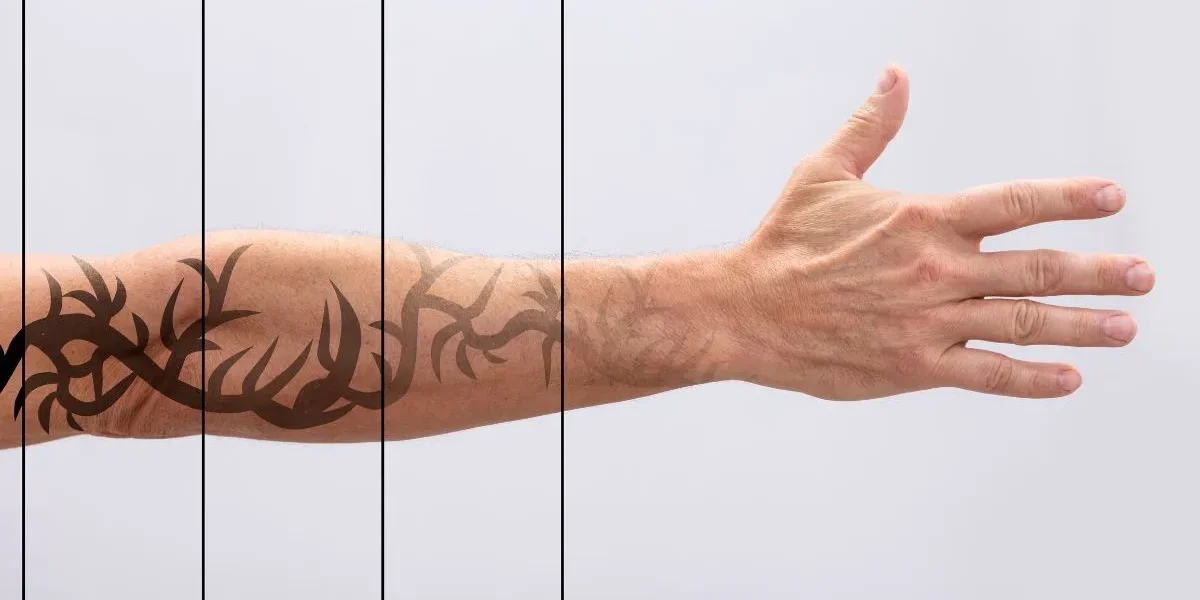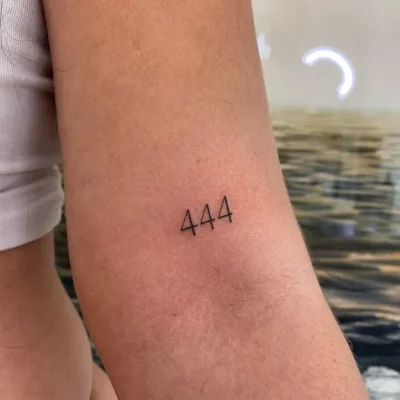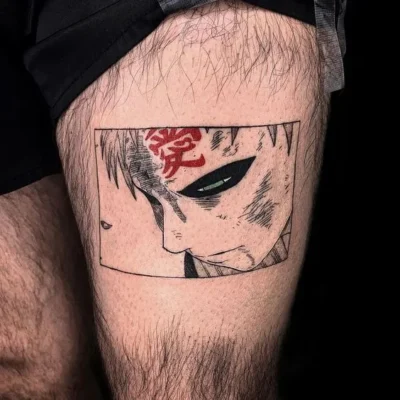Getting a tattoo is often an intense outcome of an emotional state. According to the Pew Research Center’s recent statistics, 69% of American adults have a tattoo as a symbol of love for someone they like. However, as individuals evolve, so do their relationships. Some of you would have a tattoo that has become more of an ‘oops’ than an ‘ooh!’ in your books.
If you are one of these people, you are in the right place to find the answers. Whether it is the remnants of a spontaneous decision or a piece of art that doesn’t vibe with you anymore, you’ll want to get rid of this tattoo. So, the first question that would cross your mind would most likely be – how many sessions to remove a tattoo will it take?
Usually, it takes about 6-12 sessions per dark tattoo removal, but the process is more complex than it seems to be. From the science behind it to what you can expect during each session, consider this tattoo aftercare blog your go-to guide to an ink-free skin canvas.
How Many Sessions To Remove a Tattoo Are Ideally Needed?
Given the unique characteristics of each tattoo and its inks, tattoo removal is a personalized process. Therefore, pinpointing how many sessions for tattoo removal are ideal is challenging. Yet, a common trend has emerged in the past few years. Most patients find successful tattoo removal in approximately 6 to 8 sessions.
Ideally, smaller tattoos can be removed within this range of sessions. In comparison, larger tattoos may need 10 or more sessions for complete removal of the tattoo inks.
However, it is essential to remember that patience is the key to this transformative process. According to research by Eric F. Bernstein, the average duration for complete tattoo removal may take about 24 to 32 weeks. This 6 to 8-month duration is based on multiple factors that control the ink removal from the skin.
Factors Affecting the Number of Tattoo Removal Sessions
The number of sessions required for successful tattoo removal isn’t a one-size-fits-all equation. Instead, a range of factors control and contribute to the ink-clearance duration of your skin and body.
From the size and ink colors of your beloved design to the unique texture of your skin, each element plays a vital role in its way. In simpler words, all these combine to determine the number of sessions needed to erase that permanent inking. Some of these factors include:
1. Inks and Pigments
Inks play the biggest role in determining the number of sessions needed for tattoo removal. The tattoo market currently uses various inks of all qualities and colors. Each type of ink has a different chemical composition. Therefore, different laser wavelengths are needed for their breakdown.
For example, grays can be removed using smaller wavelengths of lasers, as it is easy to remove. On the other hand, bright shades like neon, blues, greens, and purples need a longer wavelength laser for complete removal.
Moreover, the amount of ink used and the depth of the dermal penetration also influence the number of treatments needed for tattoo removal. All these factors combine to determine how easy or difficult it is to remove the ink. This factor, in turn, determines how many sessions to remove tattoo ink are needed.
2. Age of Tattoo
The age of the tattoo is the second most important factor in determining the total tattoo removal sessions. It is like a silent dance partner in the removal process – The older, the wiser, and often, the quicker to bid goodbye.
This factor is because older tattoos often respond more efficiently to removal treatments than fresh ink. The background science is that the body’s natural processes, like cell turnover and fading, start the breaking down process of the pigments over the years.
Meanwhile, the ink particles in a newer tattoo tend to be more vibrant and tightly held within the skin. So, they require additional sessions for the laser to fragment and eliminate them effectively.
3. Size of Tattoo
Generally, larger tattoos take more sessions to erase because they contain more ink and cover a larger surface area. Smaller tattoos might need fewer sessions, as there’s less ink to break down.
However, intricately detailed designs can also pose a challenge, requiring extra sessions for thorough removal. It’s like trying to erase a big, colorful mural compared to a small doodle — The more ink and complexity, the more patience needed for complete removal. Therefore, it is always wise to consult a professional to get a personalized estimate of how many sessions to remove a tattoo ink you need.
4. Location of Tattoo on the Body
Medically, areas with more blood flow, like the arms and near the heart, tend to fade tattoos faster. This is because the immune system can flush out ink particles efficiently. Conversely, tattoos on lower blood flow regions, like ankles, may require more sessions.
So, skin thickness matters. Thinner skin on wrists may clear tattoos quicker than thicker skin on the back. In short, blood flow, skin thickness, and lymphatic drainage influence tattoo removal making some spots easier or trickier to erase.
5. Your Skin Type
Your skin type also plays a vital role in determining how many sessions to remove a tattoo you will need. To be more specific, it all depends upon the amount of melanin your skin has. Melanin, in medical terms, is the pigment that gives your skin color. More melanin means darker skin tone, and less melanin means lighter skin tone.
If you’re on the fair side, congrats – you’re in luck! Lighter skin types often respond more efficiently to laser treatments. It means you’ll need fewer sessions for complete tattoo removal as less melanin makes laser targeting of ink molecules easier.
On the flip side, you’ll need more sessions to target the underlying ink if you have a darker skin tone. Moreover, with darker skin, the challenge lies in avoiding damage to the surrounding skin. Hence, you need to be more careful while getting your laser done.
6. Your Health and Immunity
Last but not least, your health status and immunity level play the biggest role in determining how many sessions are needed to remove the tattoo ink. Imagine your immune system as an army of a state. Like a powerful army defending its territory, similarly, an active immune system helps clear up your skin and blood of broken ink particles after every laser season.
A healthy immune defense aids in faster healing after each laser session, potentially reducing the overall number of sessions needed. On the other hand, the opposite is true for poor health conditions. So, while hitting the gym won’t erase your tattoo magically, it might just give your immune system the superhero boost it needs to tackle that ink!
How Much Gap Is Needed Between Each Session?
Just like tattoo making, tattoo removal also has its intricacies. Navigating the intricacies of tattoo removal requires a strategic approach. It includes the essential element of timing between sessions.
So, how many sessions to remove a tattoo? – The general rule is to wait about 6 to 8 weeks between sessions. This gap allows your skin to heal and your body to flush out the shattered ink particles.
During a tattoo removal session, lasers break down the ink into smaller particles that your body can naturally eliminate. But it’s not a one-and-done deal. “Giving your skin a breather between sessions helps minimize the risk of side effects like scarring. This trick gives your immune system the time it needs to do its magic”, says Kelly Walla, opinion leader for SkinMedica.
So, think of it as a bit of a patience exercise. Taking the time to space out those sessions ensures a smoother and more effective tattoo removal process. Your skin will thank you for it in the long run!
Is Dark Tattoo Removal a Painful Process?
Tattoo removal varies from tattoo to tattoo. Some tattoos are more accessible to remove, whereas others take time and extra effort to dissolve. If you are wondering how many sessions to remove a black tattoo are needed, the answer is a few more!
Removing a dark tattoo can be more uncomfortable because it demands heavier laser beams for breakdown. However, the pain varies from person to person. Some people describe this feeling as tiny rubber bands snapping against your skin. Others consider it the same numbing feeling you get when getting a tattoo.
In a nutshell, it all depends on you! Your pain tolerance can make the removal process a walk in the park. Or it can make it unbearable. However, the good thing is you can always ask for a numbing cream from your technician to help you!
Conclusion
Getting a tattoo removed is a personal choice. Likewise, how many sessions to remove a tattoo you’ll need is also personalized, as every tattoo has unique characteristics. While no magic number exists for complete removal, the experimented count is 6-8!
Moreover, tattoo removal is challenging, but it can be worth it if you are unhappy. Remember to follow the tattoo aftercare guide and be patient with the results. You can achieve clear and smooth skin in no time with a suitable laser and tattoo removal technician.








